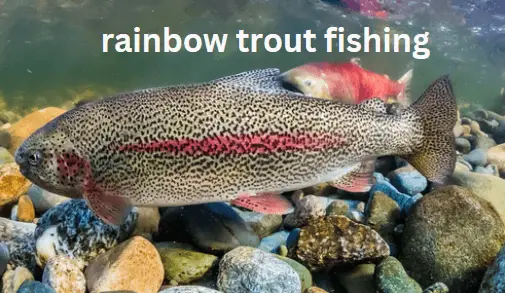Rainbow trout fishing is a popular and exciting activity, with rainbow trout being the most commonly caught of all trout species. Known for their energetic fighting and acrobatic displays, they are a thrilling catch for anglers.
Rainbow trout can be found in cold-water tributaries of the Pacific Ocean in Asia and North America, making them readily accessible to many fishing enthusiasts. Whether you’re a beginner or an experienced angler, learning the best time to fish for rainbow trout and the most effective bait options can greatly enhance your fishing experience.
Additionally, these trout often inhabit scenic mountain and river areas, providing a captivating backdrop for your fishing endeavors. Understanding their behavior and habitat preferences will help you locate the best places to find and catch rainbow trout, ensuring an enjoyable and rewarding fishing trip.
Rainbow Trout Fishing Setup
Rainbow trout fishing setup involves using light tackle and matching the hatch with various bait options like Powerbait, worms, and live nymphs. Early morning and late afternoon are the best times to fish for rainbow trout, known for their exciting game quality and being the most commonly caught species among all trouts.
Fishing Rod: Invest in a medium-action rod for optimal rainbow trout fishing. A medium-action rod provides the flexibility to handle the trout’s energy.
Reel: Choose a lightweight reel with a smooth drag system.This reel type allows for easier casting and control during the fight with the trout.
Line: Opt for a light monofilament or fluorocarbon line.Light lines are less visible to the trout and offer better sensitivity for detecting bites.
Hooks: Use small hooks in sizes 10 to 14 for rainbow trout.Smaller hooks help maintain the natural presentation of bait and improve hooksets.
Bait And Lure Selection
Natural Baits: Consider using worms, minnows, or insects as live bait.
Rainbow trout are attracted to the natural movement of live baits in the water.
Artificial Lures: Try spinners, spoons, or small crankbaits for lure fishing.
These lures mimic the movement of prey and can trigger aggressive strikes from trout.
Safety And Regulations
Check Local Regulations: Ensure you have the required fishing license and understand catch limits. Following regulations helps conserve trout populations and protects the environment.
Safety Gear: Wear appropriate clothing and footwear for a comfortable fishing experience.Safety gear such as a hat and polarized sunglasses can enhance visibility and protection.
Remember to pack essential fishing gear, adopt the right fishing techniques, and adhere to safety regulations for a successful rainbow trout fishing adventure. Whether you are a beginner or an experienced angler, these setup tips can improve your chances of landing the prized rainbow trout.
Rainbow Trout Fishing Techniques
Discover effective rainbow trout fishing techniques for a successful catch. Learn how to use light tackle, find the right structure, match your surroundings, read the water, and use various baits to increase your chances of success. Improve your fishing skills and enjoy a thrilling fishing expedition.
Rainbow Trout Fishing Techniques:
Using Light Tackle: Use light fishing tackle, such as a medium-sized spinning rod and reel, when targeting rainbow trout. Light tackle allows for precise casting and better control while reeling in the fish.
Finding Structure: Look for underwater structures, such as rocks, fallen trees, or submerged vegetation. These structures provide hiding spots for rainbow trout and increase your chances of catching them.
Matching Your Surroundings: Rainbow trout are known to be highly aware of their surroundings. Use lures or bait that mimic the natural food sources found in the specific waterbody you’re fishing. For example, if insects are prevalent, opt for insect imitation lures or live bait.
Reading the Water: Learn how to read the water to identify the best spots for rainbow trout. Look for areas where the water flow changes, such as eddies, riffles, or submerged logs. These areas often hold trout.
Understanding Rainbow Trout Behavior:
Rainbow trout tend to be more active during the early morning and late afternoon. Take advantage of these feeding periods for better fishing success. Also, pay attention to the water temperature and weather conditions, as they can affect trout behavior.
Using Live Bait: If allowed and preferred, using live bait can be highly effective when fishing for rainbow trout. Popular live bait options include worms, minnows, or insects like grasshoppers or crickets.
Casting Techniques: Practice different casting techniques, such as a gentle underhand flip or a sidearm cast, to accurately place your bait or lure near potential trout hiding spots. Avoid making loud splashes that could scare the fish away.
Patience and Stealth: Rainbow trout can be easily spooked, so it’s important to approach the fishing spot quietly and avoid making sudden movements. Be patient and give the fish time to bite. If you don’t get a bite after a while, try changing your bait or lure.
Fishing in Spring or Fall: Spring and fall are prime seasons for rainbow trout fishing, as the water temperatures are usually more favorable for these fish. Consider planning your fishing trips during these seasons for a higher chance of success.
Learning from the Experts: Follow professional anglers, watch instructional videos, or join fishing communities to learn more about effective . Tips and tricks from experienced anglers can help you improve your chances of catching this elusive fish.
Remember, practice makes perfect, and the more you fish for rainbow trout, the better you’ll get at honing your skills and developing effective techniques.
Rainbow Trout Fishing Tips
Enhance your Rainbow Trout fishing game with tips for using light tackle, finding structure, and reading the water to catch these elusive beauties effectively. Explore various bait options like Powerbait Trout Nuggets, worms, and live minnows for a successful angling experience.
Make the most of early mornings or late afternoons for optimal Rainbow Trout fishing results.
Fishing for rainbow trout can be a rewarding and exciting experience, but understanding the best techniques and strategies can significantly improve your chances of success. Below are some valuable to help you make the most out of your next fishing trip.
Understand the behavior of rainbow trout:
Rainbow trout are known for their cautious nature and tend to be easily spooked. It’s essential to approach fishing for rainbow trout with patience and a keen understanding of their behavior in different environments.
Use lightweight tackle: When targeting rainbow trout, it’s crucial to use lightweight fishing tackle to match their smaller size and strength. Consider using a light action rod and a reel with a smooth drag system for a more effective fishing experience.
Present your bait naturally: Rainbow trout are often found in clear, pristine waters where natural presentation is key. Whether you’re using live bait, artificial lures, or flies, ensure that your approach mimics the natural movements and appearances of their prey.
Pay attention to water temperature and location: Rainbow trout thrive in cool, oxygen-rich waters. When planning your fishing trip, consider the temperature and location of the water body, as these factors can greatly influence the trout’s feeding patterns and behavior.
By incorporating these rainbow trout fishing tips into your angling approach, you can increase your chances of landing these beautiful and elusive fish. Keep in mind that each fishing adventure is unique, so be prepared to adapt your strategies based on the specific conditions of the water body you’re targeting.
FAQs
What Is Best Bait For Rainbow Trout?
For rainbow trout, the best bait options include Powerbait Trout Nuggets, worms, live nymphs, minnows, kernel corn, colored marshmallows, and salmon eggs.
What Is The Best Time To Fish For Rainbow Trout?
The best time to fish for rainbow trout is early morning, from dawn until about two hours after sunrise. The next best time is late afternoon, from about three hours prior to sunset until dusk.
Is Rainbow Trout Easy To Catch?
Yes, rainbow trout are relatively easy to catch and are especially fun on light tackle. They are an exciting game fish and are commonly caught, often jumping after being hooked. Fishing for rainbow trout is a rewarding experience in scenic mountain and river areas.
Where Is The Best Place To Find Rainbow Trout?
The best place to find rainbow trout is in cold-water tributaries of the Pacific Ocean in Asia and North America. They can also be found in rivers and lakes draining into the Pacific. These areas offer a scenic environment and are ideal for catching these exciting game fish.
Last Word
Rainbow trout fishing offers an exciting and enjoyable experience for fishing enthusiasts. With their vibrant colors and energetic nature, rainbow trout are not only a delight to catch but also make for a delicious meal. Whether you’re a beginner or an experienced angler, the thrill of reeling in a rainbow trout is always worth it.
From using the right bait to fishing during the optimal times of the day, there are various strategies to ensure a successful catch. So, grab your fishing gear and head to the nearest river or lake for an unforgettable rainbow trout fishing adventure.


